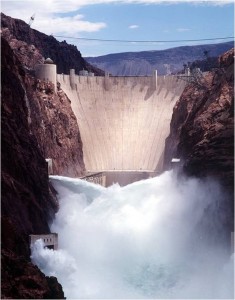 Often termed the country’s “silent renewable,” hydropower is the nation’s largest renewable electricity resource, providing 7% of total generation. Hydropower’s many supporters – 81% of U.S. voters favor maintaining existing hydro, according to a recent National Hydropower Association poll – value its low-cost, reliability and ability to integrate intermittent renewable resources. Critics argue that hydropower is not environmentally-friendly and, if included in state Renewable Portfolio Standards, will reduce the growth of renewables like wind and solar power.
Often termed the country’s “silent renewable,” hydropower is the nation’s largest renewable electricity resource, providing 7% of total generation. Hydropower’s many supporters – 81% of U.S. voters favor maintaining existing hydro, according to a recent National Hydropower Association poll – value its low-cost, reliability and ability to integrate intermittent renewable resources. Critics argue that hydropower is not environmentally-friendly and, if included in state Renewable Portfolio Standards, will reduce the growth of renewables like wind and solar power.
Historically, the U.S. Army Corps of Engineers and the Bureau of Reclamation built the vast majority of major federal dams with integrated hydroelectric generating plants in the United States. Hydroelectric dams contribute billions of dollars each year in revenue to the U.S. Treasury and provide enough generating capacity to power 72 to 96 million homes (NHA) across 38 states (EIA). However, many of these plants are operating well beyond their design life, and as a result, experiencing decreasing reliability. Moreover, high operational demand from a new era of integrating variable generation and evolving energy imbalance markets is increasing the prevalence of costly unplanned outages.
At the national level we need to prioritize hydropower and reaffirm its place in the conversation about renewables. Significant capital is necessary to rehabilitate and modernize the United States’ hydroelectric dams for reliable operation well into the future. Unfortunately, funding streams in the federal budget over the past 20 years consistently have been inadequate to maintain this entire critical infrastructure at acceptable levels of performance and efficiency.
What role should hydropower play in the nation’s energy future? Should there be a greater emphasis on funding the rehabilitation and modernization of hydropower dams? What are the implications of the aging hydropower dam infrastructure on the nation’s economic growth and energy security?
Nate, great article on hydrpower, and pleased to join this organization! Stephen
The natural limitations of traditional hydro power are clearly evident. With climate change some of the existing locations also have new problems with water reserves that limit their capability to… Read more »
Hydropower and the other water energy technologies (tidal, wave, ocean currents and thermal) are vital in providing a 24 hour, no waste, zero-emission energy solution. Existing hydropower dams can be… Read more »
Yes, there are many opportunities to rehabilitate the existing hydropower infrastructure with state-of-the art technology for this ultra-mature operation. This technology modernization includes higher efficiency turbines that generate more energy, use less water and are… Read more »
Nearly all of us in the energy industry will completely agree that hydropower has an essential role in a low carbon energy future. Hydroelectric plants have generated 2/3 of all… Read more »
CALIFORNIANS ARE BEING CHEATED California’s politicians neglect their opportunity to get water storage for droughts and save 12 billion dollars on electricity, by using hydro from existing Canadian dams, already… Read more »
Mr. Sandvig points out some of the admirable traits of hydropower and begs the question why is it the overlooked renewable. There are two specific problems holding back future… Read more »
Where we focus our investments in energy infrastructure is an important policy decision that drives economic development and our prosperity. Existing hydropower is cheaper and more efficient; however, these… Read more »
The Senate Committee on Environment and Public Works is holding a field hearing today in Conowingo, MD on a related issue. Entitled “Finding Cooperative Solutions to Environmental Concerns with the… Read more »
Conowingo is a major clean energy provider. Unfortunately, since it is a hydro this truth goes largely unnonitced when Friends of the Green Horny Toad (sic) show up at a… Read more »
There seems to be a reasonable understanding that hydropower could be a major contributer to our clean carbon free energy needs; although some may hold that water may be less… Read more »
Hydropower is the backbone of America’s renewable energy past, present, and future. Currently the nation’s largest source of electricity, we’re constantly reminded of the tremendous untapped potential that exists throughout… Read more »
CLEAN ENERGY STARVATION IN THE MIDST OF PLENTY. (511 words) Linda Church Giocci highlights the vast” Overlooked” hydro potential from existing US dams needs modernising .There was a… Read more »
Though I am coming late to the conversation, which has many positive points of discussion, I must say it is disappointing to see the effects of wholesale damming on migratory… Read more »
While there are many benefits of hydropower, this is not to suggest that our clean hydro legacy didn’t come at a cost. In the Pacific Northwest, building and operating what… Read more »